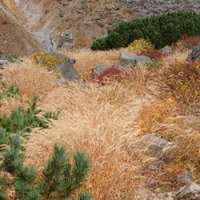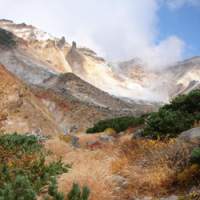The autumnal season of change is upon us once more, with delights for eye, ear and nose. As the thermometer dips, rises and falls erratically, some days seem almost balmy as if it is late spring or early summer; others carry a stronger hint of the chill to come as winter approaches.
The forest floor is damper now, fungi abound, and their scents mix with that of damp leaf mold. Overhead, leaves are drying, curling, turning and fading, while underfoot, newly fallen leaves form a multicolored carpet. The rustling sound beneath my boots carries into the air, but there the sound is the dry rustle of shimmering wings -- for this is also the season of autumn red dragonflies, and they are about in huge numbers.
I find autumn a strangely nostalgic season. At one and the same time it provides me with a pleasant reminder of the attractions that the coming winter holds (frost, ice and snow, clamoring hordes of swans, gatherings of eagles and cranes, winter-furred foxes), but also hints of endings, of another summer's passing and of activities still unaccomplished.
The erratic autumnal weather somehow echoes, or perhaps triggers, my own moods. In sunshine, I long for the outdoors, while low clouds steal away the views and rain makes me chafe at my inactivity. Part of me is still driven toward ever more activity, though inside, another part of me hints at hibernation as a welcome alternative for the winter ahead.
With each weekend that I spend outdoors comes a perverse anticipated pleasure, almost a sense of relief, at being forced by the odd rainy day to remain inside, there to catch up with the summer's backlog of chores. That is the theory -- the reality is that I am more likely to daydream the time away imagining what I would do if I were outside.
Endless temptation
The arcane chemical processes going on around us contribute to the sounds and scents of autumn that provide endless temptation to head out into the forest. Plants that have, all spring and summer, produced light-converting chlorophyll in their leaves to power their growth, are now shifting phase.
As the days shorten and temperatures fall, they cease to produce this life-giving pigment. And, as chlorophyll breaks down other pigments and their colors, those that were previously masked by the presence of chlorophyll can now be seen. It is the oranges, reds and purples of carotene and anthocyanin that are revealed -- and with them the glorious autumn colors that bring "leaf-peepers" (leaf tourists) out in droves to watch and photograph them.
In the weeks and months ahead, in areas blessed with an abundance of maples, fiery leaves will bring long snaking lines of traffic to the mountains. Forsake those lines and instead find a quiet backwoods trail and explore this mellow season on foot, allowing your nose and ears to delight in the season as well as your eyes.
In recent weeks I have watched as the wild roses growing along the shore of the Sea of Okhotsk here in Hokkaido have presented their last flowers to the wind and their fruits have reddened and swelled to eventually become food for migrant birds. In the Daisetsu Mountains I have seen the glorious contrast of deep-green Japanese stone pines bordered by orange-leaved rowan trees, their colors appearing to flow down the mountainsides like burning lava.
Closer to home, I have made my autumnal pilgrimage to wander on the flanks of Kamuishiri, a favorite mountain in western Hokkaido. By returning to the same trail each year, and from season to season, I feel grounded among familiar foliage. After a prolonged spell spent overseas in a whirlwind of travel, there is something reassuring about the familiarity of a natural landscape. Here I can feel the slow pace of change of the seasons, I can recognize the inhabitants of those forests and welcome them with a thrill, like well-known friends.
Hiking up a familiar trail I was soon aware of the warming sun tempting the lingering dragonflies to swarm up into shimmering squadrons above my head, rustling like so many translucent leaves. Their days are numbered now, but while they are in decline, fungi are on the rise. Puffballs seem everywhere, as are innumerable parasol-shaped fungi, the white-flecked red-capped Amanita among them, all helping to break down the accumulated organic matter, the detritus of a long summer now lying on the forest floor. This is recycling on a grand and natural scale, and joining in and actively reprocessing, too, in the dampness of the forest floor, are countless snails and slugs.
Tiny rasping teeth
Snails are Mollusca in the class Gastropoda, but that rather grand-sounding scientific name has a very down-to-earth meaning -- being "stomach foot." The terrestrial snails, most of which are herbivorous, have a fantastic structure hidden in their muscular "foot" -- namely their radula. This is a chitinous ribbon, a kind of conveyor belt armed with tiny rasping teeth with which the snail can gather food while grazing across any substrate. Marine snails graze on algae; terrestrial snails graze across leaves and other organic debris, and even fungi -- as seen in the photograph (left) -- a case of one recycler being recycled by another.
Forest hiking trails in autumn are often crisscrossed by the slime trails of slugs and snails. These sticky quicksilver strands are the drying remnants of mucus that these mollusks produce to reduce friction and aid their movement across uneven surfaces. At the best of times their pace is slow, a mere millimeter or so a second, so tracking them is easy; follow the trail, search beneath the leaf litter and you'll be amazed at how many species you can find. With 60,000 to 70,000 species described worldwide, naming them isn't that easy -- but watching them is. Where larger animals typically flee at the sound or sight of us, invertebrates such as snails live out their lives at a pace that is easy to observe.
In the case of the creature pictured here, not only was it in no hurry to go anywhere, it was completely engaged in staying still -- where it could rasp away at the surface of a decaying mushroom. It is in situations like this that a small pair of binoculars comes in very handy; flip them over and they make a fine field microscope. In this case, mine gave me splendid views of this snail's two pairs of pneumatic tentacles. These bizarre structures can retract back into the head at the least disturbance, only to emerge slowly again as the creature relaxes. It is through these four "feelers" that snails and slugs "see" the world; the upper pair is light sensitive while the lower pair provides a sense of smell.
It is easy to speed on past the colorful delights of autumn, but take a hint from the snails -- slow down, get down low, soak up the season, and take in the sights and scents of fall from a new perspective.





















With your current subscription plan you can comment on stories. However, before writing your first comment, please create a display name in the Profile section of your subscriber account page.